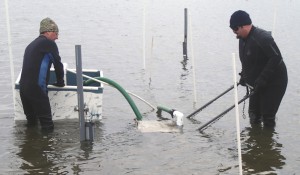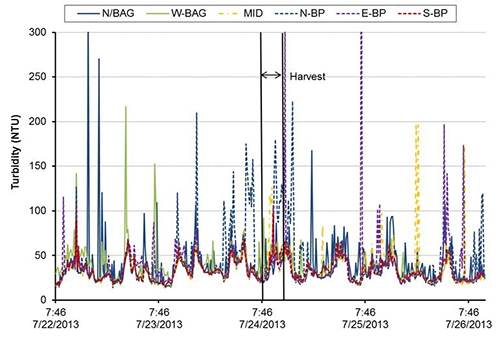Home » Projects » Shellfish Aquaculture Production and Management Projects » Preliminary Assessment of Harvesting Bottom-planted Hard Clams on Aquaculture Leases
Home » Projects » Shellfish Aquaculture Production and Management Projects » Preliminary Assessment of Harvesting Bottom-planted Hard Clams on Aquaculture Leases

To advance alternative culture and harvest methods for the commercial production of hard clams, the environmental impacts of harvesting bottom-planted hard clams with a pump-driven device were evaluated. Water quality and soil physiochemical properties were monitored during three comparative harvest replicates to determine if effects were similar or less disruptive to those associated with harvesting clams grown in bottom bags, the culture method typically used by Florida growers.
Hard clam Mercenaria mercenaria juveniles (average 33 mm length, 11 grams weight) were bottom planted in triplicate under cover nets (9 mm mesh polyester material, 8’x10’, 80 ft²) and in bottom bags of the same material (16 ft² per bag, belt of 5 bags, 80 ft² per replicate belt) and cultured for 6-7 months at the University of Florida experimental lease located within the Dog Island Aquaculture Use Area near Cedar Key. A “box” harvester in which a 5 hp pump delivers pressurized water via nozzles along a spray bar was used to harvest bottom-planted clams. At harvest, survival and growth characteristics of hard clams from each culture method were determined. To assess product quality of hard clams harvested by these two methods, shell breakage and shelf life in refrigerated storage were also measured.
A Before-After, Control-Impact, Paired (BACIP) sampling design was employed to examine effects of culture methods and harvesting practices on various parameters, and to differentiate natural changes from those caused by harvesting. To investigate water quality disturbances associated with the two harvest methods, seven sondes were deployed in cardinal directions five feet from the perimeters of both the bottom plant and bag replicates with one sonde placed midway between the culture units. Water quality parameters (temperature, salinity, dissolved oxygen, and turbidity) were measured continuously for a period spanning 48 hours pre- and post-harvest. Harvest replicates were treated as independent evaluations as ambient conditions (tides, wind, and background levels) differed for each harvest activity.
Prior to planting, soil cores were collected to establish baseline condition for particle size distribution (sand and fines), organic matter content, and bulk density. Additional soil cores were collected repeatedly at 0, 2, and 4 weeks post-harvest to evaluate potential changes in soil properties at the bottom plant and bag sites, as well as at reference (unfarmed) sites located between the culture sites. Cross-sectional soil elevation profiles were monitored to capture tracks created by bottom plant and bag harvest activity and their recovery over time (2, 4, and 8 weeks post-harvest).
Production: Commercially acceptable production of hard clams was attained using the bottom plant method with cover nets. However, survival was significantly lower (82%) than for hard clams cultured in bottom bags (95%). Bottom-planted clams were significantly larger (49 mm length) and heavier (37 grams weight) than clams cultured in bags (47 mm, 33 g). Yields between the two culture methods did not differ (1.9 kg/ft²).
Product Quality: In a literature review, damage to hard clams harvested by a hydraulic rake was reported to be low (<5%). In this study, breakage of hard clams harvested from bottom plants and bags was similar and also low (0.4-0.5%). Use of a pump-driven device to harvest hard clams should not result in increased damage to the clams. Survival of clams from each culture method averaged 95% after 10 days in refrigerated storage (<45°F).

Water Quality: Turbidity (a measure of water clarity) was the only water quality parameter observed to change during harvesting of clams. The magnitude of turbidity was greater with the pump-driven harvester in two of the three replicate harvests. In the first two replicates, turbidity conditions returned to background levels within 6-24 minutes after pulling the bags from the bottom and within 19-75 minutes after harvesting bottom-planted clams. High variability in turbidity values was observed during the 48 hours before and after harvest. In the first replicate (see figure), the highest values measured during the background monitoring were 328 NTU pre-harvest and 441 NTU post-harvest, whereas the highest value measured during the use of the pump-driven harvester was 329 NTU. These observations suggest elevated turbidity conditions are common within the study area and natural events can and do induce turbidity values higher than harvest activity.
Soil Properties: Harvesting methods had no significant effect on soil properties when compared to reference (unfarmed) soils at harvest (week 0) and post-harvest sampling (2 and 4 weeks). However, soil bulk density was significantly higher at bottom plant sites than bottom bag sites. A significant increase in bulk density occurred from week 0 to week 2 within bag culture sites, but by week 4, values returned to reference site values. The average depth of tracks created by the pump harvester was not statistically different from depressions created by harvesting clams in bottom bags. These tracks/depressions were starting to fill when soil elevations were measured at 2 weeks post-harvest. By weeks 4 and 8, the depth of the tracks continued to diminish at bottom plant sites, while depressions at bag sites increased slightly in depth. Changes that occurred post-harvest were due to natural dynamic processes (for example, tides, wave action) found in inshore coastal environments.
Summary: This study was designed to preliminary assess the environmental effects of using a pump-driven device to harvest bottom-cultured hard clams. Changes in turbidity conditions and soil properties were short term and reversible. Due to the limited scale of the harvest activity, adverse impacts to shellfish aquaculture leases located in shallow coastal environments are unlikely.
The final project report below can be viewed in PDF format.
Preliminary Assessment of Harvesting Bottom-planted Hard Clams on Aquaculture Leases (427 KB)
Sturmer, L., Osborne, T., and Ellis, R. 2014. Final Report to Florida Sea Grant College Program, 10 pp.